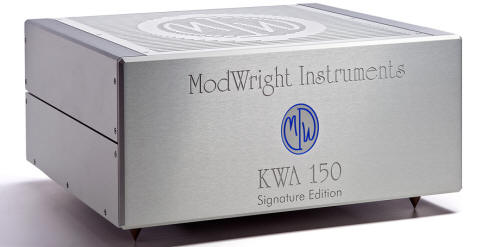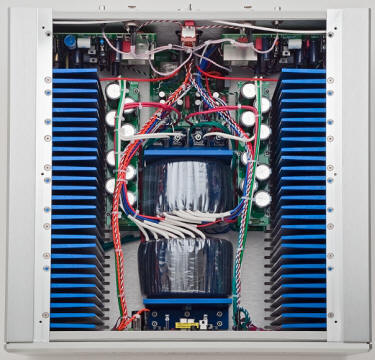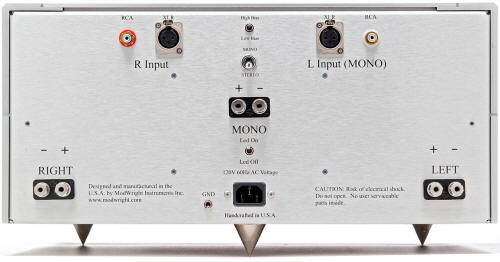This year’s Rocky Mountain Audio Fest was another great show. Even with almost three full days, there is so much interesting gear, new and not-so-new, that I often hurried through the hundreds of components and rooms to be able to see and hear everything of interest. I usually start at the top floors of the two hotel buildings and work down, which makes taking the stairs a worthwhile exercise to bypass the long lines of attendees waiting for the elevators. Modwright Instruments had amplifiers in a number of rooms on the upper floors, so there were numerous opportunities to hear the latest products from mod-master Dan Wright, and also to talk with him about the new Signature Edition version of the KWA150 stereo amplifier.

I was able to listen to the 150 Watt per channel KWA 150 SE in my system for about three weeks following the show. While this audition period is sufficiently extended to develop definite opinions about the performance of an audio component, it is not really long enough for the degree of in-depth appraisal and testing with other components that is required for a full review and rating on our “LP” scale.
The build and parts quality of the Modwright amplifier is impressive for a product that is made to sell for $8500. Attention to detail in the layout and fit of internal wiring is up to the standards of life-saving medical equipment. This is a true dual-mono amp, including separate power transformers for each channel. Spiked feet are provided for the 84 pound weight of this solidly built amplifier with nicely sculpted aluminum faceplate. The machined top plate, with the large logo, can be lit from inside with a blue glow with the flip of a rear panel switch labeled “LED On”. The amplifier can be easily switched to a 650 Watt “monoblock” powerhouse. The only feature that I missed was a remote trigger turn on facility. The amplifier can be operated in either high-bias or low-bias mode. In high-bias, which is definitely preferred due to greater harmonic depth and natural smoothness resulting in increased listening enjoyment, the amplifier draws about 3 Amps/250 Watts at idle. In low-bias, the power used is about 1.1A/85W.
Other components on hand during the audition included a SOTA Cosmos IV vacuum turntable with Triplanar VII u2 tonearm, SOTA Satellite turntable with Origin Live Zephyr tonearm, Amazon Referenz turntable, Moerch DP-8 Anisotropic tonearm, Miyajima Kansui, Shilabe and Premium Mono phono cartridges, Bob’s Devices CineMag 3440 step-up transformers and Bob’s brand new CineMag 1131 “Blue” step-up transformers, Rogue Ares and Lamm LP2 vacuum tube phono preamplifiers, Prism Orpheus Digital Interface with custom Windows 7 computer/music server, YG Acoustics Kipod Main Modules speakers, YG Acoustics Kipod II Signature Main Modules (OMG), Dali Mentor 5 speakers (from the home theater system), and Gallo TR-3 subwoofers. Power amplifiers included B&K Reference 125.2, Cary SA200.2, and Manley Snappers. Interconnects and speaker cables are mostly Mogami. All front end components, including the preamplifiers, receive their AC power from a PS Audio AV-5000 power conditioner which is connected to the wall power with a 1 meter length of PS Audio PerfectWave AC-10 power cord. Other AC-10s were used elsewhere in the system, and I use Jerry’s DIY power cords on the music computer and Levinson preamp. An Audience aR2p-TO power conditioner or PS Audio Quintet is normally used for the power amplifiers.

The KWA 150 SE has no trace of solid-state edge, glare or grain in high-bias mode. All frequencies are very clean, pure and open sounding, especially in the entire treble range. There is remarkable detail in the leading edge of all notes that provides fast transients and a very high degree of sparkle and shimmer. The ability to hear the exact beginning of a sound with no blurring is a mark of a fine amplifier and a very positive and important sonic ability. This character aids in localizing a performer in space on the virtual sound stage and contributes to the amplifier’s excellent delivery of the size of the recording venue and location of individual performers.
The Modwright amplifier also offers outstanding low level resolution and micro-dynamics, so it is not necessary to listen with the volume turned up to hear all of the detail in your favorite recordings. The wood sticks at the beginning of “Water of Love” on the Dire Straits white album have outstanding impact in that instant when the sticks make contact. Compared to the Manley Snapper amplifiers (with 6CA7 output tubes), which have become long-term residents due to their very life-like harmonic richness and consistent quality across the octaves, the Manleys have more the sound of oiled wood resonance and a bit less power in the impulse of the sticks contacting each other. On the same cut, Mark Knopffler’s voice sounds younger through the Modwright, but with a wonderful abundance of rich harmonic overtones. The cymbals ring more clearly and the fade to silence lasts just a bit longer while the Manleys offer the cymbals with more of the brass metal character.
The bass performance of the amplifier is truly outstanding. In all areas – impact, resolution, and consistency of tone – from the lowest bass and up to the midrange, the Modwright KWA 150 SE amplifier is faultless. The bass is never fat or overdone, but neither is it weak or reticent. On “Six Blade Knife” of the same Dire Straits LP, the bass line is perfectly focused, easy to follow, tuneful and powerful. This band likes powerful bass and the Modwright transmits their vision perfectly.
I have followed the career of Joan Armatrading for several decades and attended her concerts wherever I have lived. She is an amazingly versatile performer, a talented songwriter, and a great guitar player. Her vocals are unmistakable and fit whatever mood the particular song requires. She is simply enchanting on “The Power of Dreams” on the Hearts and Flowers LP. The Modwright’s ability to communicate her distinctive voice is very near perfection.

I greatly enjoyed my limited time with the Modwright KWA 150 SE amplifier. It can sometimes sound a bit too clear and extended in the mid- to upper-treble, especially with extremely revealing loudspeakers like the YG Acoustics Kipod II Signature Main Modules. The treble range could be a bit overwhelming if you prefer the more relaxed upper frequency presentation of a single-ended triode vacuum tube amplifier, or if your listening room is highly reflective or “bright”. However, this is an issue of character, not quality of sound. The Modwright has the overall sonic excellence, natural midrange, consistency of tone, bass performance, and sound staging proficiency that makes it easily competitive with anything I have heard at or near its general price range. Some competitors with which I have recent experience include the Levinson 532H, Aesthetix Atlas, Parasound JC-1, Bryston 7B SST2, and Pass X250.5. From this field, I would choose the exceptional Modwright KWA 150 Signature Edition amplifier for long term satisfaction.
Link to manufacturer’s Web site: Modwright Instruments
